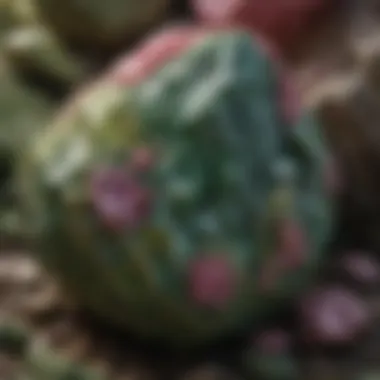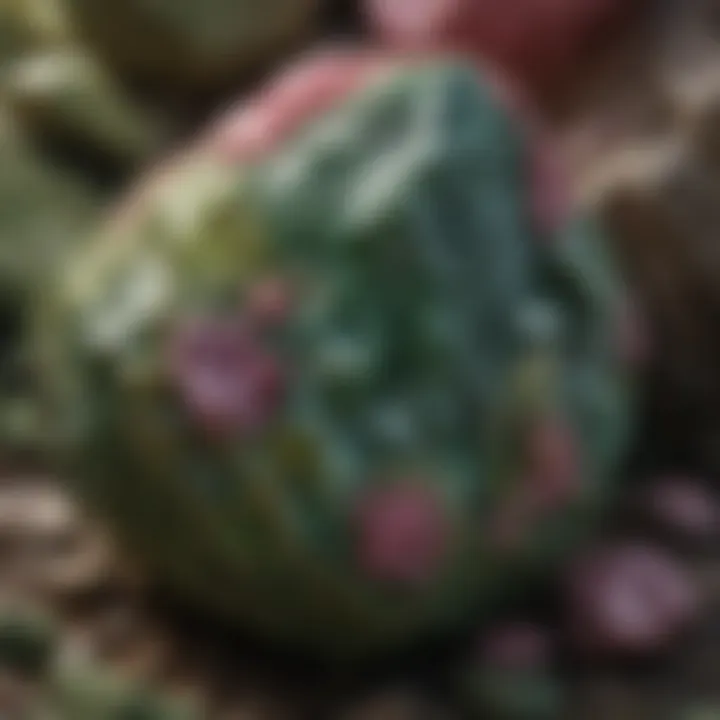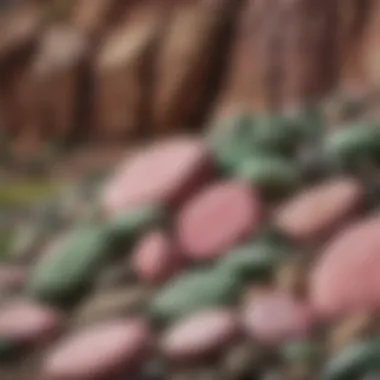Exploring the Significance of Pink and Green Rocks


Intro
Pink and green rocks are often overlooked jewels in the vast tapestry of geology. These striking minerals not only add an aesthetic touch to nature, but they also bear fascinating stories of formation, evolution, and human connection. This article ventures into the depths of these colorful rocks, dissecting their formation processes and shedding light on their ecological significance. Many collectors value them dearly, drawn not only by their appearance but also by their historical and cultural narratives.
Understanding the allure behind pink and green rocks requires more than just an understanding of their geological makeup; it encompasses the appreciation of their role in various ecosystems and their journey into the hands of collectors who often treat these stones as treasures. How they’re formed, what makes them unique, and how enthusiasts identify them are just some of the intriguing topics we will explore herein.
Delving deeper into the realm of these captivating rocks reveals not only their geological underpinnings but also their intersections with artistry and culture, making them a centerpiece of interest for both amateur fossilers and seasoned geologists alike.
Preface to Pink and Green Rock
Rocks come in many hues and tints, but few capture the imagination quite like pink and green varieties. These colorful stones are not just visually stunning; they tell stories of the Earth's history, its geological processes, and the cultures that have interacted with them. This section will dive into why pink and green rocks matter, shedding light on both their scientific and cultural significance.
Definition and Geological Significance
When it comes to geology, pink and green rocks signify much more than just pigment. Pink rocks, often formed from mineral compositions that include feldspar or quartz, exhibit rich colors thanks to the presence of elements like iron. Green rocks, on the other hand, can stem from mineral groups such as serpentine or chlorite, often formed under high-pressure conditions in metamorphic settings.
Understanding these definitions helps in appreciating how minerals react under various conditions, creating the vibrant colors and textures we cherish. The significance extends to how these rocks contribute to our grasp of geological time—some may even host fossils, unveiling secrets of past life on Earth.
Overview of Colors in Geology
Colors in geology are not merely aesthetic; they're a narrative read by those who know where to look. Pink and green hues arise from different mineral compositions, environmental influences, and the mere age of the rocks themselves. For instance, the interplay of temperature and humidity can affect mineral stability, which in turn influences color.
- Pink Rocks: Typically seen in granites or quartzites, where feldspar reacts with environmental factors.
- Green Rocks: Part of the metamorphic rock family, their greenish color often indicates the presence of specific minerals, revealing their geological origins.
In summary, colors tell us about the rocks' life story, including the conditions they weathered and the time span across which they formed. You could say colors in geology give us a colorful timeline to decode the Earth’s past.
"Rocks are the Earth's biography, and their colors provide crucial context to the tale."
In working with pink and green rocks, enthusiasts gain insights that connect them to both nature and history. This exploration not only enhances appreciation but also aids in the identification and understanding of these unique geological wonders.
Formation Processes of Pink and Green Rocks
Understanding the formation processes of pink and green rocks is essential for appreciating their unique characteristics and appeal. These rocks emerge from different geological environments and conditions, contributing to their fascinating colors and textures. Delving into these processes reveals not just their origins but also enhances the knowledge of collectors and enthusiasts who seek these geological treasures. This section will unravel the complexities behind the formation of these striking rocks, highlighting significant elements that set them apart.
Igneous Formation
Types of Igneous Rocks
When we talk about igneous rocks, we’re mainly referring to rocks that solidify from molten material. Different types like granite, basalt, and pumice can display vibrant shades of pink and green. Granite, for instance, often contains quartz and feldspar which can give a pink hue while sometimes incorporating mafic minerals like biotite or hornblende that lend a greenish tone. The combination certainly catches the eye and appeals to collectors who appreciate the variety.
What makes granite so appealing in this context is its widespread availability and durability. It’s not just about looks; granite's resistance to weathering means that pink and green varieties can retain their beauty for long periods, particularly in jewelry or decorative applications. However, as you sift through collections, one must keep in mind that the granite’s origins can be traced back to deep within the Earth’s crust, lending it a historical significance too.
Cooling Rates and Color Variations
The cooling rate of magma plays a crucial role in determining the color and texture of igneous rocks. Rapid cooling, like that occurring at the surface, forms fine-grained textures such as those found in basalt, which sometimes showcases a slight green hue due to the presence of certain minerals like olivine. On the other hand, slower cooling beneath the crust allows for larger crystals to form, resulting in rocks like granite.
This variance in cooling not only contributes to the color but also affects how light interacts with the surface, making some rocks more lustrous. For collectors, understanding these processes enhances appreciation; it's not just a rock but a story of temperature and time captured in mineral forms.
Metamorphic Origins
Pressure and Temperature Effects
Metamorphic rocks exhibit dramatic transformations due to exposure to high pressure and temperature conditions. During these changes, existing minerals can become unstable and reconstitute into new minerals. Pink and green hues often result from this metamorphic activity; for example, schist can take on a stunning green from chlorite or green biotite resulting from pressures found deep within the Earth.
The intricate interplay of these conditions is significant for collectors. Collecting metamorphic rocks can feel like owning a slice of Earth's dynamic history where pressure, heat, and time shaped the very fabric of the rock. With this, you’re not just gathering rocks; you’re curating geological marvels formed under extreme conditions that reflect Earth’s inner workings.
Mineral Changes and Color Development
As metamorphic conditions press on rocks, mineral changes emerge prominently, giving rise to distinctive colors. For instance, quartz may remain largely unchanged, but feldspar can transform and manifest pink shades in gneiss or migmatite. The interplay of colors signifies various minerals present; where you find pink, you might often discover elements like potassium.
This ability of minerals to shift and change in color is a vital part of understanding geological discovery. Collectors who recognize these color cues also develop an eye for identifying their specimens with greater accuracy, enhancing their collections significantly.
Sedimentary Contributions
Chemical Processes Leading to Color Variation


In sedimentary rocks, chemical processes can lead to fluctuating colors. Iron oxides may impart everything from vibrant reds to deep greens depending on the chemical environment during lithification. For example, rocks like sandstone can take on reddish hues due to the oxidation of iron while others, such as greenstone, display mineral rich colors due to the presence of chloritic material.
By comprehending these processes, collectors not only benefit from richer narratives behind their rocks but also build more comprehensive collections that reflect the sedimentary environment. Without a doubt, the chemical variations are a treasure trove for anyone keen on geology.
Role of Organic Material
Interestingly, organic material plays a substantial role in the deposition and color variation in sedimentary rocks. Organic remains can influence color as they decompose, leaving interesting patterns and shades. For instance, carbon-rich deposits can turn rocks dark, while lithified plant materials may lead to unique coloration.
This organic aspect adds layers of intrigue for collectors, intertwining the biological history of the Earth with its geological story. Not only do you collect rocks, but pieces of the planet's life processes that tell of ancient environments, giving depth to any collection.
Understanding the formation processes of pink and green rocks paves the way for collectors to truly appreciate their commitment and investment in this hobby. Each rock embodies a rich tapestry of geological history, waiting to be unlocked through knowledgeable exploration.
Identification and Classification
Understanding the identification and classification of pink and green rocks is the bedrock of any collector or enthusiast's journey. It not only aids in recognizing specimens but also enriches the appreciation of these geological marvels. Identifying these rocks can give insights into their origin, usage, and aesthetic appeal, which are crucial for collectors aiming to build a valuable collection.
Color Analysis Techniques
Visual Inspection
Visual inspection acts like the first impression at a gallery. It’s often the first step in identifying pink and green rocks. This method involves carefully observing the rock’s surface conditions, color variations, and overall appearance. What stands out here is the immediate sensory feedback; one can often distinguish between variations in hue just by sight. When collectors hold a specimen up to the light, they might notice subtleties that reveal a rock’s story and origins.
One benefit of visual inspection is that it's accessible; no special tools or training are necessary. A novice can start this way, quickly learning to differentiate between common specimens. However, its limitations become apparent when one encounters more complex varieties that require deeper analysis or when color alone misleads the identification.
Use of Geological Tools
In contrast to the straightforwardness of visual inspection, the use of geological tools offers a more intricate approach to identification. Instruments like hand lenses or rock hammers can unveil the unseen layers of complexity hidden within each rock. This technique can not only confirm a collector’s initial assumptions but can also reveal properties that the naked eye might miss, such as structural integrity or chemical components.
Why is this a popular choice among collectors? It combines science with appreciation, providing a more nuanced understanding of a rock’s characteristics. However, it requires a bit of investment, both in terms of finances for quality tools and time to learn their effective use. Over-reliance on these tools without foundational knowledge can lead to incorrect classifications, showcasing their advantages and disadvantages.
Key Characteristics to Observe
Mineral Composition
Mineral composition plays a critical role in identifying pink and green rocks. By examining the specific minerals that constitute a rock specimen, one can deduce its geological history. For instance, a pink granite typically contains feldspar, quartz, and mica—all of which contribute to its distinctive coloration.
The highlight here is how mineral composition can guide collectors in discerning varieties not just by color but also by formation process. Someone delving into serious collecting would find this essential because knowing the minerals can help them understand how rocks fit into the broader geological puzzle. A downside is that identifying minerals requires a certain skill level and potentially supplemental resources like mineral guides or educational courses.
Texture and Luster
Texture and luster are often the final touches that define a rock's character. Texture can vary widely; a smooth, polished green rock can evoke different qualities than a rough, pink one. Collectors often look for specific textures that can signify unique formation conditions.
Luster offers insight into the rock’s surface reflective qualities—whether it’s dull, glossy, or somewhere in between—which can assist in classification. The key characteristic of texture and luster dependency is its ability to complement the color analysis, giving collectors a full-bodied view of the specimen.
However, collectors should keep in mind that these aspects can sometimes be altered due to weathering, which could impact accurate classification. Noticing these nuances enhances the collector's experience and understanding, reinforcing the importance of a holistic approach to identification.
Cultural and Historical Significance
Understanding the cultural and historical significance of pink and green rocks is paramount in appreciating not just their geological properties, but also the rich tapestry of human experience surrounding them. These vibrant rocks have served as more than mere geological curiosities; they have been pivotal in shaping art, architecture, and even mythologies across various cultures. Their inherent beauty and unique formation processes provide a fascinating backdrop to their role in human history and our environment.
Use in Art and Architecture
Historical Examples of Use
Throughout history, pink and green stones have found their way into various architectural styles and artistic expressions. One notable example is the use of pink granite in ancient Egyptian temples. This rock not only manifested strength but added an ethereal quality with its striking hue, capturing the attention of artisans and architects for millennia. In this context, the choice of pink granite is not just a functional one but also an aesthetic decision that conveys power and divinity. Similarly, green marble has often adorned classical structures and sculptures, symbolizing both luxury and elegance. This characteristic richness in color makes it a preferred choice for sculptors, as it offers depth and vibrance to both grand facades and intricate artworks.
Modern Interpretations
In contemporary settings, pink and green stones continue to inspire. Recent architectural projects have integrated these colors to evoke a sense of connection with nature. For instance, towns that utilize green slate and pink sandstone in their modern buildings often see an increase in tourism, owing to the picturesque charm these materials impart. The unique feature of modern interpretations lies in their ability to blend ancient aesthetics with sustainable design. While these stones seek to marry beauty with functionality, they also face challenges such as cost and availability in specific regions, which sometimes limits their widespread adoption.
Symbolism and Folklore
Regional Beliefs
Across various cultures, pink and green rocks carry significant symbolic weight. In some Indigenous cultures, for example, pink stones are seen as symbols of love and compassion. They are often incorporated into important rituals meant to foster communal ties or during significant life events. The key characteristic of these beliefs is their intrinsic connection to nature and community. This often makes them a beneficial addition to meaningful gatherings or ceremonies. However, one downside is that these beliefs can sometimes be overshadowed by their aesthetic appeal in modern contexts.
Associated Legends


Legends surrounding pink and green rocks are rich and diverse. For instance, many cultures weave tales of how these stones formed from the tears of ancient deities or the remnants of a great battle. Such stories often serve to imbue these rocks with a sense of mystique, elevating them beyond mere geological specimens. The allure of these legends not only adds layers of meaning but also cultivates interest among collectors. However, it’s essential to acknowledge that while these legends enrich the narrative, they might lead some enthusiasts to overlook the scientific nature of rock formation, which is equally fascinating.
Ecological Role of Pink and Green Rocks
Pink and green rocks serve notable roles in various ecosystems, influencing not just geological features but also biological communities. Their diverse compositions contribute significantly to habitat formation, soil development, and even fossil preservation, thus intertwining geology with the lives of countless organisms.
Habitat Formation
Ecosystem Dynamics
The presence of pink and green rocks can shape ecosystems in profound ways. These rocks often alter the physical landscape, creating niches that support various plant and animal species. For instance, their unique mineral content can help foster diverse vegetation patterns, which in turn attracts different animal life. This contributes to a dynamic balance in the ecosystem where every organism plays its part.
Having rocks that provide shelter and shade can lead to increased biodiversity, making them essential in conservation efforts. However, it’s vital to note that not all ecosystems react similarly.
Impact on Soil Composition
Pink and green rocks can profoundly influence soil composition, affecting the fertility and structure of the soil. As these rocks weather over time, they release essential minerals that plants need to thrive.
This mineral enrichment can lead to a more robust growth of flora, which forms the basis of food webs. On one hand, healthy soil promotes richer biodiversity; on the other hand, if the rocks contain harmful minerals, the impact could be detrimental to local flora and fauna. Thus, understanding soil interaction with these colorful rocks is crucial.
Fossil Detection and Preservation
Indicators of Fossil Locations
Certain pink and green rocks have characteristics that can indicate fossil-rich areas. Their formation processes often coincide with fossil deposits. For example, sedimentary layers containing these vibrant rocks may signal past environments that harbored life.
By analyzing these geological markers, collectors and scientists can pinpoint potential fossil sites. The unique feature here is that they act as geographical signs, guiding enthusiasts to fruitful digging spots. However, not every indication leads to a treasure trove, as results can vary by region and rock type.
Preservation Techniques
When it comes to fossils, the techniques used for preservation can determine whether a collector’s find survives the test of time. Some methods include using consolidated materials that don’t react with the fossil, while other techniques might involve controlled environments to manage humidity and temperature.
These practices are essential for maintaining the integrity of fossil specimens, ensuring they retain their scientific and aesthetic value. Yet, improper techniques can lead to irreversible damage, so caution is paramount.
In summary, the ecological significance of pink and green rocks is vast, ranging from fostering biodiversity to guiding fossil collectors. They symbolize a balance where geology and biology meet, forming complex relationships that speak to the health of our planet.
Collecting Pink and Green Rocks
Collecting rocks, especially pink and green varieties, is not just a hobby; it’s a passion that intertwines geology, art, and history. These unique colored rocks capture the imagination of enthusiasts and seasoned collectors alike, serving as vibrant symbols of nature’s artistry. Engaging with these specimens opens a window into the earth’s processes and time. Not only do they enrich personal collections, but they also contribute to a broader understanding of geological diversity.
Tips for New Collectors
Collecting for the first time can be as exciting as it is daunting. Here’s what you need to know.
Field Trip Essentials
When venturing out to collect pink and green rocks, preparation is essential. Field trip essentials include sturdy shoes, a backpack, and tools like hammers and brushes. These items help ensure both safety and successful collecting. Among these tools, a field guide tailored to your region can be invaluable. It not only helps in identifying the rocks but also in learning their origins. Additionally, bringing along a sturdy water bottle is crucial, as you might be out for hours.
The key characteristic of these essentials is their practicality. For instance, having a good quality hammer can make a significant difference in breaking apart tough rocks without damaging the specimens you want to keep. A well-prepared collector is more likely to have an enjoyable and productive outing.
"Preparation is half the battle when you’re exploring nature’s treasure chest."
Local Regulations and Ethics
Understanding local regulations and ethics is crucial for responsible collecting. Different regions have varying rules about rock collecting. Some places might require permits, while others may prohibit collection altogether. Knowing these regulations shows respect for nature and the law.
A notable feature of these regulations is the emphasis on conservation. Many locations enforce restrictions to protect fragile ecosystems. For instance, if you’re in a national park, rules often limit collection to ensure preservation. Ignoring these guidelines can not only result in penalties but also harm the environment, which defeats the spirit of the hobby.
Advanced Collector Strategies
As you become more invested in collecting, consider diving deeper into the community and learning about advanced techniques.
Networking with Other Collectors
Networking with other collectors can greatly enhance your experience. Whether it’s through social media or local clubs, connections with others can provide insights into new collecting grounds and valuable tips on identification. Many collectors share their experiences, allowing you to learn from their successes and mistakes.
One unique feature of networking is the access to collective knowledge. You might learn about rare finds or get invited to group excursions that would otherwise be challenging to navigate alone. The camaraderie can also add a social element to the hobby, making it more enjoyable.


Participating in Collecting Events
Participating in collecting events like rock shows or field trips organized by geological societies serves to broaden your experience and skill. These events often feature experts who can give talks on specific topics, share identification tips, or teach you how to clean and preserve your finds properly.
Moreover, these gatherings present a unique opportunity to meet fellow collectors who share your passion. You’ll find people who have all sorts of stories about their journeys into the world of geology and collecting. Not only can you swap stories and advice, but you may also find new friends in the process.
Overall, each of these strategies—whether networking or attending events—enhances your collecting experience, making it richer and more fulfilling.
Care and Preservation Techniques
Taking care of pink and green rocks is not just about keeping them clean; it’s about ensuring their integrity for future generations to enjoy. Proper care and preservation techniques enhance their appeal and longevity, making them worthwhile additions to any collection.
Cleaning Guidelines
Maintaining the vibrant colors of pink and green rocks relies heavily on effective cleaning methods. Here are two essential aspects to consider:
Appropriate Cleaning Agents
When it comes to cleaning these special rocks, choosing the right cleaning agents is quite crucial. Many collectors lean towards using pH-neutral soap mixed with warm water. This method gently cleans the surface without causing unwanted reactions. It’s a common choice because it minimizes the risk of damaging delicate minerals.
Another popular option includes using distilled water. This can help to bypass the contaminants often found in tap water, which might potentially harm the stones. A major advantage of these cleaning agents is their gentle properties, ensuring that the beautiful colors of the rocks remain intact during the process.
However, one should be careful not to use acidic or abrasive cleaners, which can dull the surface or create scratches that mar their beauty.
Methods to Avoid Damage
Preventing damage while cleaning involves a few straightforward but effective methods. First off, using soft brushes like a toothbrush provides a gentle means of scrubbing without scratching. It's a popular choice because it allows collectors to reach into crevices without harming the rock’s surface.
Moreover, avoiding chemical cleaners and opting for natural methods, as mentioned earlier, works wonders. A unique feature of this approach is that it reduces the risk of chemical reactions with the rock’s material. This can be particularly important for rarer samples that may have unknown properties.
The downside? Some stubborn stains may not be completely removed without stronger chemicals, but the risk of damage outweighs that concern for many collectors.
Storage Recommendations
Once your rocks are cleaned, proper storage becomes the next priority. Let’s delve into two key elements:
Environmental Considerations
The environment where you store pink and green rocks is critical. High humidity or direct sunlight can lead to discoloration or even deterioration. Storing them in a cool, dry place is best, often a closed cabinet or display case that shields them from various elements.
Another characteristic that collectors find beneficial is using silica gel packets to control moisture levels in storage areas. This unique method helps maintain an optimal humidity level, reducing the risk of damage significantly. Conversely, storing rocks in overly dry environments might lead to cracking, showing there’s a fine balance to strike here.
Display Tips for Collectors
When it comes to displaying pink and green rocks, aesthetics and security should go hand in hand. Placing them behind glass cabinets keeps them safe from dust and potential mishaps that might occur during day-to-day life. This not only showcases their beauty but also keeps them protected.
A unique feature of effective display practices is that collectors can arrange rocks based on color gradients or shapes, enhancing visual appeal while preserving their integrity. The downside, however, is that too much exposure without protection can lead to scratches or fading. Balancing display with care is essential for showcasing these natural treasures effectively.
Proper care and preservation of pink and green rocks not only maintains their allure but ensures they can be appreciated in the best possible condition for many years to come.
Ending and Future Perspectives
The exploration of pink and green rocks reveals a landscape filled with complexities and fascinating stories. It’s essential to recognize that the continued research in this field is not just an academic exercise; it has practical implications for both geology and collecting. As we dive into Continued Research in Geology, we uncover why understanding these colored rocks is imperative not only for scientific inquiry but also for preserving cultural heritage.
Continued Research in Geology
With the advancement of technology in geological studies, researchers have more tools at their disposal than ever before. Techniques such as isotope analysis and geophysical surveys enable scientists to delve deeper into the processes that form these rocks. For instance, research focusing on the mineral composition of pink rocks can reveal their formation history and the environmental conditions at the time of their genesis. This kind of data is invaluable; it can help in reconstructing ancient climates and ecological conditions.
Moreover, ongoing studies could help clarify how these unique rocks might respond to current environmental changes. Understanding the stability of these formations can be key in anticipating geological events, which can, in turn, inform collecting practices to ensure sustainability among enthusiasts.
Scientists also focus on the economic aspects, looking into the potential for mining related to pink and green rocks. As collectors continue to showcase their preferences, there’s a real need for sustainable extraction methods that minimize ecological damage.
The Evolution of Collecting Trends
The landscape of rock collecting is ever-changing, and it's critical to observe how these trends adapt over time. Fascination with pink and green rocks continues to grow, influenced by the shifting tides of societal values and scientific discoveries. In the past, the focus was often on purely aesthetic values; however, today’s collectors are more informed and considerate.
Presently, many collectors emphasize authenticity and provenance. A notable trend is the increasing demand for ethically sourced specimens. Collectors are more interested in knowing where their rocks come from, leading to a shift towards partnerships with responsible mining operations.
Additionally, online communities such as Reddit or specialized Facebook groups provide platforms for collectors to share insights, experiences, and even market their finds. These digital spaces break down geographical barriers, allowing discussions on local regulations, conservation practices, and current research findings.
Here are a few trends shaping the future of pink and green rock collecting:
- Emphasis on Conservation: More collectors are inclined to participate in conservation efforts, ensuring the protection of rock formations.
- Educational Workshops: With increasing complexity in identifying rocks, workshops aimed at both novice and veteran collectors are becoming popular.
- Collaborative Exhibitions: Partnerships between museums and collectors have started to bloom, showcasing the beauty and significance of pink and green rocks to a broader audience.



